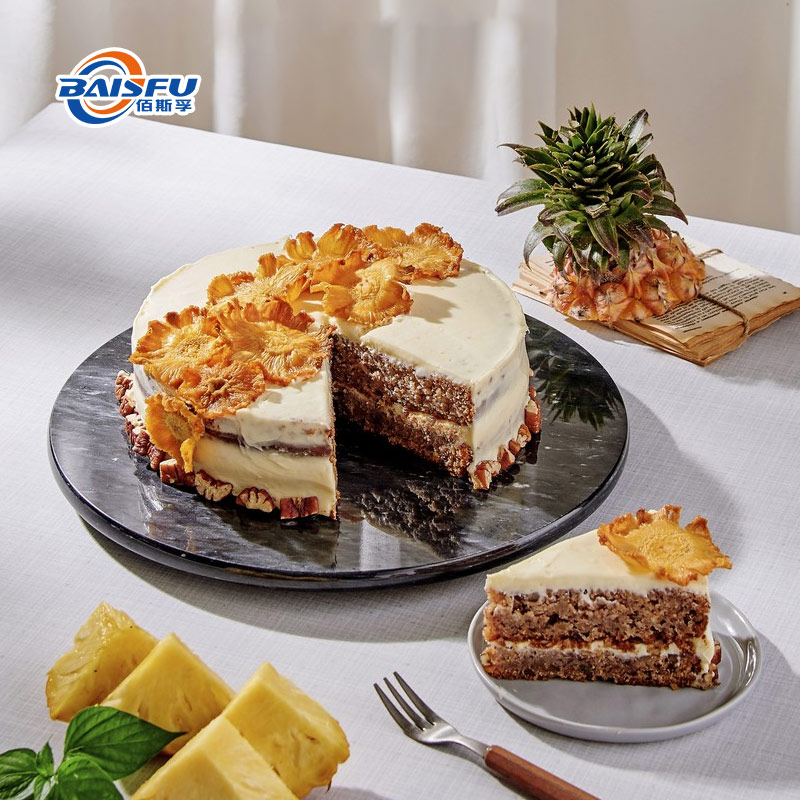Pineapple flavor: tropical-flavored "artificial sunbathing"

1. Four core characteristics of pineapple flavor
1. “Molecular translator” of tropical flavor
Natural pineapple contains more than 120 volatile components, and the core flavor is synergistically constructed by allyl caproate (fruity flavor), ethyl butyrate (creamy sweet flavor) and furanone (caramel flavor). Pineapple flavor is accurately reproduced through two major paths:
Natural extraction: cold-pressing pineapple peel residue to obtain ester substances (yield is only 0.02%);
Chemical synthesis: butyric acid and ethanol ester are combined to form the main fruity flavor, reducing costs by 95%.
Modern flavors also add γ-nonalactone to enhance the milky aftertaste and simulate the complex layers of mature pineapples.
2. “Flavor fighter” of high temperature and time
Baking stability: microencapsulation technology allows it to withstand high temperatures of 200℃, and natural pineapple juice produces a cooked and stuffy taste at 80℃;
Long-term preservation: the aroma retention rate is >90% within the shelf life of 18 months, and fresh-cut pineapples ferment and become sour after refrigeration for 7 days.
3. “Industrial Leverage” of Cost and Efficiency
Economical efficiency: 1kg concentrated flavor is equivalent to the flavor value of 300kg fresh pineapple, and transportation loss is almost zero;
Universality: Water-soluble, oil-soluble, and powdered flavors are suitable for ice cream, hard candy, baking and other scenarios.
4. “Contradictory Reconciler” of Health and Innovation
Zero allergens: Does not contain bromelain (a substance that causes oral irritation), so sensitive people can eat it with peace of mind;
Sugar reduction revolution: Use flavors to simulate fruit sweetness in sugar-free beverages and reduce bitterness after sugar substitutes (such as erythritol).
2. Five major application areas of pineapple flavor
1. Food industry: “time and space folding” of flavor
Baking magic: Pineapple bun filling does not require real fruit pulp, and flavor + winter melon puree simulates the sweet and sour fiber feeling;
Frozen food: Pineapple pizza sauce can withstand freezing at -18℃, and there is no flavor loss after thawing;
Plant-based revolution: Vegetarian meat products add smoked pineapple flavor to cover up the fishy smell of pea protein
2. Beverage Industry: From Nostalgia to Cyberpunk
Classic Soda: Sprite Pineapple Limited Edition uses flavors to avoid pulp sedimentation problems;
New Tea Drinks: Heytea “Pineapple Coconut” relies on flavors to balance the heaviness of coconut milk;
Alcohol Innovation: Pineapple flavor + tequila to create a “fruitless version” of Pina Colada.
3. Daily Chemical Products: Tropical “Sensory Trap”
Toiletries: Shampoo adds pineapple flavor (β-caryophyllene) to create the concept of “juice shampoo”;
Home Cleaning: Floor Cleaner uses pineapple fragrance instead of chemical lemon acid to enhance the pleasure of use;
Fragrance Economy: Car diffusers launch the “Tropical Holiday” series to simulate the atmosphere of an island vacation.
4. Medicine and functional food: bitter “sweet assassin”
Children’s medicine: mask the bitterness of ibuprofen suspension, and improve medication compliance by 40%;
Meal replacement optimization: high-protein bars use pineapple flavor to neutralize the fishy smell of whey protein;
Pet snacks: dog chew sticks add pet-safe flavors to stimulate the desire to eat.
5. Industrial innovation: unexpected “cross-border players”
Environmental materials: biodegradable plastic bags are injected with pineapple flavor to mask the corn fermentation smell of PLA plastic;
Agricultural technology: synthetic pineapple pheromones are used to trap fruit flies and reduce the use of pesticides;
Virtual reality: VR restaurant experience is paired with a flavor diffuser to enhance the immersion of the “tropical fruit feast”.

